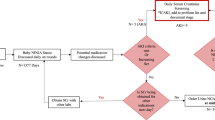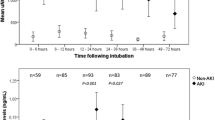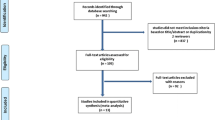Abstract
Background
Nephrotoxic medication exposure is a common cause of acute kidney injury (AKI) in hospitalized children. A key component of the NINJA quality improvement initiative is systematic daily serum creatinine assessment in non-critically ill children exposed to ≥ 3 nephrotoxic medications on 1 day, or intravenous aminoglycoside or vancomycin for ≥ 3 days. Daily venipuncture is invasive and associated with disposable and personnel healthcare costs. Urine neutrophil gelatinase-associated lipocalin (uNGAL) is a marker of renal tubular injury associated with certain nephrotoxic medications. We investigated whether uNGAL is a reliable screening tool for AKI in NINJA and could decrease the need for daily venipuncture.
Methods
This two-center prospective study enrolled 113 children who met NINJA criteria from May 2018 through March 2019. Daily urine samples were obtained for up to the first 7 days of qualifying exposure and 2 days after exposure ended. Our primary outcome was severe AKI (KDIGO stage 2 or 3 AKI). Maximum uNGAL was highest concentration on the day of, or 3 days prior to, severe AKI. The highest uNGAL level from all assessment days was used for patients who did not develop AKI or severe AKI.
Results
Urine NGAL thresholds of 150 and 300 ng/ml demonstrated excellent specificity (92.4 and 97.1% respectively) and negative predictive values (93.3 and 92.8% respectively) for ruling out severe AKI.
Conclusions
We suggest that uNGAL could be used to supplant some of the daily serum creatinine venipunctures in NINJA. The most optimal combination of serum creatinine and uNGAL assessment requires further study.

Similar content being viewed by others
References
Hui-Stickle S, Brewer ED, Goldstein SL (2005) Pediatric ARF epidemiology at a tertiary care center from 1999 to 2001. Am J Kidney Dis 45:96–101
Zappitelli M, Parikh CR, Akcan-Arikan A, Washburn KK, Moffett BS, Goldstein SL (2008) Ascertainment and epidemiology of acute kidney injury varies with definition interpretation. Clin J Am Soc Nephrol 3:948–954
Goldstein SL, Kirkendall E, Nguyen H, Schaffzin JK, Bucuvalas J, Bracke T, Seid M, Ashby M, Foertmeyer N, Brunner L, Lesko A, Barclay C, Lannon C, Muething S (2013) Electronic health record identification of nephrotoxin exposure and associated acute kidney injury. Pediatrics 132:e756–e767
Goldstein SL, Mottes T, Simpson K, Barclay C, Muething S, Haslam DB, Kirkendall ES (2016) A sustained quality improvement program reduces nephrotoxic medication-associated acute kidney injury. Kidney Int 90:212–221
Goldstein SL, Dahale D, Kirkendall ES, Mottes T, Kaplan H, Muething S, Askenazi DJ, Henderson T, Dill L, Somers MJG, Kerr J, Gilarde J, Zaritsky J, Bica V, Brophy PD, Misurac J, Hackbarth R, Steinke J, Mooney J, Ogrin S, Chadha V, Warady B, Ogden R, Hoebing W, Symons J, Yonekawa K, Menon S, Abrams L, Sutherland S, Weng P, Zhang F, Walsh K (2020) A prospective multi-center quality improvement initiative (NINJA) indicates a reduction in nephrotoxic acute kidney injury in hospitalized children. Kidney Int 97:580–588
Stoops C, Stone S, Evans E, Dill L, Henderson T, Griffin R, Goldstein SL, Coghill C, Askenazi DJ (2019) Baby NINJA (Nephrotoxic Injury Negated by Just-in-Time Action): reduction of nephrotoxic medication-associated acute kidney injury in the neonatal intensive care unit. J Pediatr 215:223–228.e226
Benoit SW, Goldstein SL, Dahale DS, Haslam DB, Nelson A, Truono K, Davies SM (2019) Reduction in nephrotoxic antimicrobial exposure decreases associated acute kidney injury in pediatric hematopoietic stem cell transplant patientS. Biol Blood Marrow Transplant 25:1654–1658
Young J, Dahale D, Demmel K, O'Brien M, Geller J, Courter J, Haslam DB, Danziger-Isakov L, Goldstein SL (2020) Reducing acute kidney injury in pediatric oncology patients: an improvement project targeting nephrotoxic medications. Pediatr Blood Cancer 67:e28396
Sterling M, Al-Ismaili Z, McMahon KR, Piccioni M, Pizzi M, Mottes T, Lands LC, Abish S, Fleming AJ, Bennett MR, Palijan A, Devarajan P, Goldstein SL, O'Brien MM, Zappitelli M (2017) Urine biomarkers of acute kidney injury in noncritically ill, hospitalized children treated with chemotherapy. Pediatr Blood Cancer 64. https://doi.org/10.1002/pbc.26538
(2012) Kidney disease: Improving Global Outcomes (KDIGO) Acute Kidney Injury Work Group - KDIGO Clinical Practice Guideline for Acute Kidney Injury. Kidney Int suppl 1-138
Schetz M, Dasta J, Goldstein S, Golper T (2005) Drug-induced acute kidney injury. Curr Opin Crit Care 11:555–565
Krawczeski CD, Goldstein SL, Woo JG, Wang Y, Piyaphanee N, Ma Q, Bennett M, Devarajan P (2011) Temporal relationship and predictive value of urinary acute kidney injury biomarkers after pediatric cardiopulmonary bypass. J Am Coll Cardiol 58:2301–2309
Zappitelli M, Washburn KK, Arikan AA, Loftis L, Ma Q, Devarajan P, Parikh CR, Goldstein SL (2007) Urine neutrophil gelatinase-associated lipocalin is an early marker of acute kidney injury in critically ill children: a prospective cohort study. Crit Care 11:R84
Haase M, Bellomo R, Devarajan P, Schlattmann P, Haase-Fielitz A (2009) Accuracy of neutrophil gelatinase-associated lipocalin (NGAL) in diagnosis and prognosis in acute kidney injury: a systematic review and meta-analysis. Am J Kidney Dis 54:1012–1024
Haase M, Devarajan P, Haase-Fielitz A, Bellomo R, Cruz DN, Wagener G, Krawczeski CD, Koyner JL, Murray P, Zappitelli M, Goldstein SL, Makris K, Ronco C, Martensson J, Martling CR, Venge P, Siew E, Ware LB, Ikizler TA, Mertens PR (2011) The outcome of neutrophil gelatinase-associated lipocalin-positive subclinical acute kidney injury: a multicenter pooled analysis of prospective studies. J Am Coll Cardiol 57:1752–1761
Funding
This project was funded by a grant from BioPorto Diagnostics.
Author information
Authors and Affiliations
Corresponding author
Ethics declarations
Conflict of interest
SLG serves as a paid consultant for BioPorto Diagnostics and receives other research grant funding from BioPorto. DA serves as a paid consultant for BioPorto Diagnostics.
Cincinnati Children’s Hospital receives royalties from BioPorto Diagnostics from licensing patent rights related to The NGAL Test™.
Disclaimer
BioPorto Diagnostics had no role in the study design, the conduct of the study, data analysis, or preparation of this manuscript.
Additional information
Publisher’s note
Springer Nature remains neutral with regard to jurisdictional claims in published maps and institutional affiliations.
Supplementary information
ESM 1
(DOCX 15 kb)
Rights and permissions
About this article
Cite this article
Goldstein, S.L., Krallman, K.A., Schmerge, A. et al. Urinary neutrophil gelatinase-associated lipocalin rules out nephrotoxic acute kidney injury in children. Pediatr Nephrol 36, 1915–1921 (2021). https://doi.org/10.1007/s00467-020-04898-5
Received:
Revised:
Accepted:
Published:
Issue Date:
DOI: https://doi.org/10.1007/s00467-020-04898-5




